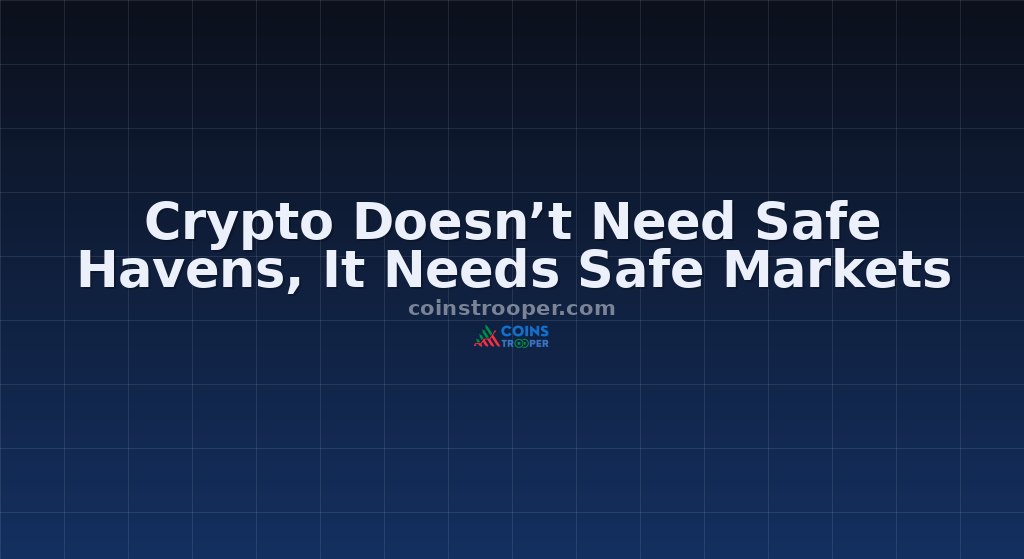Crypto Doesn’t Need Safe Havens, It Needs Safe Markets

- Crypto has never needed “safe havens.” It needs safe markets.
- A safe haven is a place to hide; a safe market is a place to build.
- Jurisdictions that understand this distinction will be the ones that capture the next significant wave of serious capital.
- The crypto industry has been in a regulatory tug-of-war for over a decade.
What Happened
The crypto industry has been in a regulatory tug-of-war for over a decade. On one side, innovators argued that too much oversight would suffocate the technology, while skeptics warned that too little would expose investors to catastrophic risk. The collapse of crypto exchange FTX in November 2022 only widened this divide even more.
Caught in the middle, many crypto businesses took on a simple playbook: they found the jurisdiction with the lightest touch, grabbed a license and called it a win. This “safe haven” strategy created short-term advantages for many of those companies. It allowed exchanges and token issuers to scale quickly, avoid tough questions and brand themselves as pioneers. Outside of the U.S. — and therefore, outside the reach of Gary Gensler, former chair of the U.S. Securities and Exchange Commission (SEC) and industry boogeyman known for his regulation-by-enforcement approach to crypto — many of those companies likely felt relief. But it also produced exactly what critics feared: markets where investor protection was an afterthought, enforcement was inconsistent and credibility was fragile.
Instead of rushing to become a permissive playground, the country took a slower, more considered approach. It invested in a comprehensive regulatory framework, launching entities like the Virtual Assets Regulatory Authority (VARA) in Dubai and the Abu Dhabi Global Market (ADGM).
The UAE’s goal was never to attract companies looking for shortcuts, but to build an ecosystem where safety and supervision are the primary focus. This matters because capital behaves differently today than it did in crypto’s early years. Retail traders may have chased offshore exchanges and high-risk offerings, but institutional investors are motivated by an entirely different calculus.
At the same time, retail investors are more cautious — the high-profile collapses of exchanges and lenders in recent years have reminded everyone that when the rules are unclear or unenforced, it is the investor who pays the price.
Market Context
Crypto has never needed “safe havens.” It needs safe markets.
The difference is more than semantics. A safe haven is a place to hide; a safe market is a place to build. Jurisdictions that understand this distinction will be the ones that capture the next significant wave of serious capital.
Pension funds, sovereign wealth funds and family offices are gravitating more and more toward markets where strategies have been tried and tested. They allocate capital in jurisdictions where they can trust the rules of the game, where custodians meet international standards and where enforcement is legitimate, that is, where laws and regulations are applied consistently, fairly, and transparently.
By positioning itself as a safe market rather than a safe haven, the UAE is sending exactly the right signal: innovation is welcome, but accountability is non-negotiable.
It’s further evidence that the UAE is evolving beyond minimum compliance, creating an ecosystem where capital, talent and fresh ideas not only converge, but thrive.
Global regulators are closing ranks, sharing intelligence, and applying pressure on markets that undercut standards. The International Organization of Securities Commissions (IOSCO) which sets the global standard for financial markets regulation has increasingly focused on crypto markets in recent years.
Markets that rely on being “easier” are already getting called out publicly. Malta was recently criticized by the European Securities and Markets Authority (ESMA) for not conducting enough due diligence before granting a license to a crypto firm.
The Coming Capital Movement
The next phase of crypto adoption will be defined less by speculative trading and more by integration into mainstream finance.
Why It Matters
The idea that a weak regulatory framework could be an asset for the crypto industry is losing traction fast. In fact, the opposite is now true. Loophole jurisdictions are becoming liabilities.
Being known as a regulatory arbitrage hub may have worked in 2017, but in 2025, it is a massive red flag.
Details
The result is a trust deficit that still weighs heavily on the industry today.
The UAE’s Regulatory Flip
The United Arab Emirates (UAE) has nailed the delicate balance in regulating crypto, carefully walking the line between innovation and safety.
Big Money Is Chasing What Is Proven
The UAE’s multi-layered regulatory environment gives crypto businesses the choice of which regulatory framework suits their operational needs. This is a reflection of the UAE’s ability to support genuine innovation and healthy competition through transparent frameworks and world-class regulatory standards.
Why “Loophole Jurisdictions” Are Fading
More recently, Malta pushed back on the push for centralized European crypto regulation, with the local securities regulator saying it doesn’t support regulatory centralization.
That means stablecoins backed by real reserves, tokenized assets with clear legal protections and exchanges that can withstand the scrutiny of institutional due diligence.

